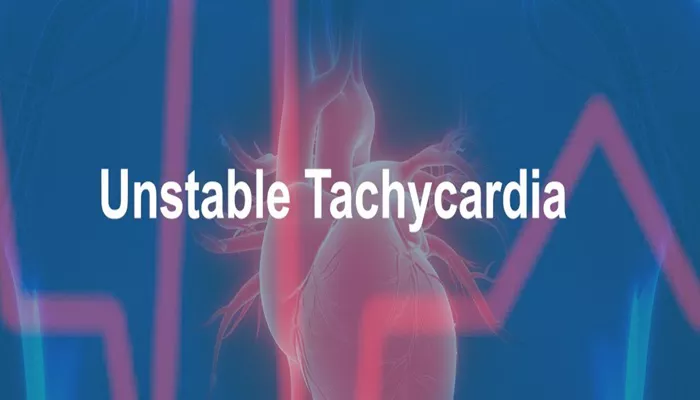Unstable tachycardia is a serious medical condition characterized by an abnormally fast heart rate that results in reduced cardiac output and can lead to severe symptoms. This condition requires immediate attention and treatment to prevent complications such as heart failure or even sudden cardiac arrest. Understanding the first-line drug treatment for unstable tachycardia is crucial for healthcare professionals and patients alike. This article will provide a detailed overview of unstable tachycardia, its symptoms, causes, and the recommended first-line drug treatments.
Causes of Unstable Tachycardia
Unstable tachycardia can be caused by various factors, including:
Cardiac Conditions: This includes arrhythmias, coronary artery disease, heart failure, and valvular heart disease.
Electrolyte Imbalances: Abnormal levels of potassium, magnesium, or calcium can disrupt the heart’s electrical activity.
Medications: Certain medications, including stimulants and some antiarrhythmic drugs, can trigger tachycardia.
Systemic Conditions: Conditions such as fever, hypoxia, anemia, or hyperthyroidism can also lead to unstable tachycardia.
SEE ALSO: When Is The Best Time to Take Pressure Medicine
Symptoms of Unstable Tachycardia
Patients with unstable tachycardia may present with a range of symptoms, including:
Chest Pain: This can be sharp or pressure-like and may indicate reduced blood flow to the heart.
Shortness of Breath: Patients may feel as though they cannot catch their breath, especially during physical activity.
Dizziness or Lightheadedness: This can occur due to inadequate blood flow to the brain.
Weakness or Fatigue: Patients may feel unusually tired or weak.
Altered Mental Status: Confusion or decreased alertness can occur in severe cases.
Syncope: Fainting or loss of consciousness may happen if the heart cannot pump enough blood.
First-Line Treatment for Unstable Tachycardia
The immediate treatment for unstable tachycardia is crucial to stabilize the patient and prevent further complications. The first-line treatment typically involves synchronized cardioversion, especially in cases where the patient is symptomatic or hemodynamically unstable.
Synchronized Cardioversion
Synchronized cardioversion is a procedure that uses electrical energy to restore a normal heart rhythm. It is indicated for patients with unstable tachycardia, particularly in the following situations:
Supraventricular Tachycardia (SVT): This includes conditions such as atrial fibrillation or atrial flutter where the patient is unstable.
Ventricular Tachycardia (VT): In cases of monomorphic VT with a pulse, synchronized cardioversion is the preferred method.
Procedure for Synchronized Cardioversion
Preparation: Ensure the patient is in a safe environment. Obtain intravenous access and monitor vital signs.
Sedation: If the patient’s condition allows, sedate them to minimize discomfort during the procedure.
Electrode Placement: Place the defibrillator pads on the patient’s chest in the appropriate positions.
Synchronize the Device: Set the defibrillator to synchronize with the patient’s heart rhythm. This ensures that the shock is delivered at the right moment in the cardiac cycle.
Deliver the Shock: Administer the shock at the appropriate energy level.
The recommended initial energy dose varies based on the rhythm being treated:
For narrow regular rhythms (e.g., SVT): 50-100 Joules.
For narrow irregular rhythms (e.g., atrial fibrillation): 120-200 Joules.
For wide regular rhythms (e.g., monomorphic VT): 100 Joules.
For wide irregular rhythms: defibrillation dose (not synchronized).
Post-Procedure Monitoring: After cardioversion, monitor the patient’s heart rhythm and vital signs closely.
Pharmacological Treatment
While synchronized cardioversion is the immediate treatment for unstable tachycardia, pharmacological agents may be used in conjunction or as alternative treatments in certain situations. The choice of medication depends on the underlying cause and type of tachycardia.
Common Medications Used
Adenosine: This is often used for the acute treatment of paroxysmal supraventricular tachycardia (SVT). It works by temporarily blocking the conduction through the atrioventricular (AV) node, which can restore normal sinus rhythm.
Dosage: Administer 6 mg as a rapid intravenous (IV) push. If the first dose is ineffective, a second dose of 12 mg may be given.
Beta-Blockers: These medications reduce heart rate and myocardial oxygen demand. They are effective in managing tachyarrhythmias and can be used for stable patients.
Examples: Metoprolol, Esmolol.
Calcium Channel Blockers: These are useful for controlling heart rate in patients with atrial fibrillation or atrial flutter.
Examples: Diltiazem, Verapamil.
Antiarrhythmic Agents: For patients with ventricular tachycardia or other arrhythmias, antiarrhythmic medications may be indicated.
Examples: Amiodarone, Sotalol, Procainamide.
Magnesium Sulfate: This is particularly effective in cases of torsades de pointes, a specific type of polymorphic ventricular tachycardia.
Dosage: Administer 1-2 grams IV over 15 minutes.
Conclusion
Unstable tachycardia is a critical condition that requires immediate intervention. The first-line treatment is synchronized cardioversion, which can quickly restore normal heart rhythm in symptomatic patients. Pharmacological agents may also play a role in managing tachyarrhythmias, depending on the underlying cause.
It is essential for healthcare providers to assess patients carefully, monitor their response to treatment, and implement long-term management strategies to prevent future episodes.


